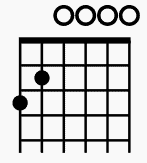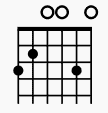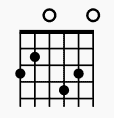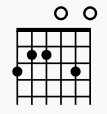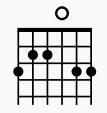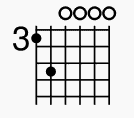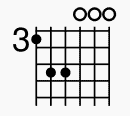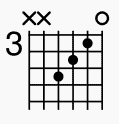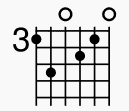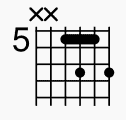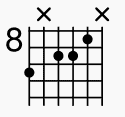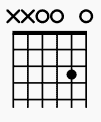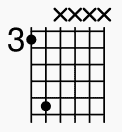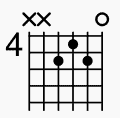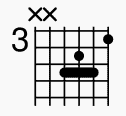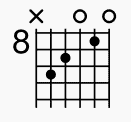The G6 chord is one of those that are actually quite easy in its most basic shape, but adds that little something to the music. One of the songs that I’m most familiar with using G6 is Behind Blue Eyes by Limp Biskit. They use it throughout the song.
As you’ll see, there are a few different ways to use this chord and various ways to play it. We’ll get into all of that, and soon you’ll be making music that’s just that little bit more interesting than basic chords.
Contents
The Theory of the G6 Chord
A little bit of music theory never goes amiss. But don’t worry, this is a very simple chord to understand. A 6th chord is just the 6th interval added onto a triad.
Basic triads use the intervals 1, 3, and 5. Let’s have a look at the G major scale, since G6 is the major G chord with a sixth interval added to it. Thanks to the circle of fifths, we know that G has one sharp, the F#.
G, A, B, C, D, E, F#
1 2 3 4 5 6 7
The G major chord is:
G, B, D
G6 looks like this:
G, B, D, E
Looking at this, you may be thinking, but wouldn’t that cause dissonance? There’s a D and an E together. And yes, yes it does. But in a way that just sounds so good. Seventh chords have much the same principle. The G6 guitar chord sounds particularly good.
How to Play the G6 Chord
Here are the various voicings of G6. You’ll see some shapes are perfect for beginners, but you can work your way up to the harder ones.
G6 Version 1
This is the easiest way to play G6.
- 1st finger: 5th string, 2nd fret (B)
- 2nd finger: 6th string, 3rd fret (G)
The open strings from 1-4 give you: E, B, G, D.
G6 Version 2
This one is also pretty easy. It’s like the G chord, but instead of fretting the first string, you fret the second string instead.
- 1st finger: 5th string, 2nd fret (B)
- 2nd finger: 6th string, 3rd fret (G)
- 3rd finger: 2nd string, 3rd fret (D)
The open strings from 1-4 give you: E, G, D.
G6 Version 3
This version may require a bit of a stretch for those with small hands. But most guitarists will have no problem with this shape when muscle memory sets in.
- 1st finger: 5th string, 2nd fret (B)
- 2nd finger: 6th string, 3rd fret (G)
- 3rd or 4th finger: 3rd string, 4th fret (B)
The open strings from 1-4 give you: E, B, D.
G6 Version 4
This one will take some practice. It can feel awkward, but angle your hand toward the 1st string slightly to fret all the necessary strings cleanly.
- 1st finger: 5th string, 2nd fret (B)
- 2nd finger: 6th string, 3rd fret (G)
- 3rd finger: 2nd string, 3rd fret (D)
- 4th finger: 3rd string, 4th fret (B)
The open strings 1 and 4 give you: E, D.
G6 Version 5
This version requires you to barre the fourth and fifth strings. It can be a bit of a struggle to do this and keep the third string open. Just play with the angle of your hand and fingers until you get it right. If you happen to mute the third string by accident, that’s fine. You’ll still get the G from the 6th string.
- 1st finger: Barre the 4th and 5th strings in the 2nd fret (E, B)
- 2nd finger: 6th string, 3rd fret (G)
- 3rd or 4th finger: 2nd string, 3rd fret (D)
The open strings 1 and 3 give you: E, G.
G6 Version 6
This is just like the previous version, but with the 1 string being fretted too. This adds a slightly sweeter tone to the chord.
- 1st finger: Barre the 4th and 5th strings in the 2nd fret (E, B)
- 2nd finger: 6th string, 3rd fret (G)
- 3rd finger: 2nd string, 3rd fret (D)
- 4th finger: 1st string, 3rd fret (G)
The open string gives you another G.
G6 Version 7
This is another very easy version to play and because of the D in the fifth fret, it has a slightly different tone to the first version. You can play this one over the first version if you’re playing with another guitarist.
- 1st finger: 6th string, 3rd fret (G)
- 2nd finger: 5th string, 5th fret (D)
The open strings from 1-4 give you: E, B, G, D.
G6 Version 8
For an even higher pitch on the lower strings, this version adds a G in the fifth fret.
- 1st finger: 6th string, 3rd fret (G)
- 2nd finger: 5th string, 5th fret (D)
- 3rd finger: 4th string, 5th fret (G)
The open strings from 1-3 give you: E, B, G.
G6 Version 9
This version will sound like a slightly higher voicing, but that’s only because it’s missing the bassier notes. It adds some variety when you need to play something more gentle sounding or just want options for picking over the chord played by someone else.
- 1st finger: 2nd string, 3rd fret (D)
- 2nd finger: 3rd string, 4th fret (B)
- 3rd finger: 4th string, 5th fret (G)
The open string gives you the E.
G6 Version 10
This is a more balanced sounding version, and can take a bit of practice. But with regular practice, you will find that it gets easier and easier. Plus, there’s no need to worry about skipping any strings.
- 1st finger: 6th string, 3rd fret (G)
- 2nd finger: 2nd string, 3rd fret (D)
- 3rd finger: 3rd string, 4th fret (B)
- 4th finger: 5th string, 5th fret (D)
The open strings give you E (1st string) and D (4th string)
G6 Version 11
This is the easier version of the above chord, although you won’t have that slightly higher D to add some sweetness to the chord.
- 1st finger: 6th string, 3rd fret (G)
- 2nd finger: 3rd string, 4th fret (B)
- 3rd finger: 5th string, 5th fret (D)
The open strings give you (1st- E, 2nd- B, 4th- D).
G6 Version 13
Here’s a chord in the mid-range, but without bass. If you’re starting to get into barre chords, this can be an easy way to do it since you don’t have to barre the entire fret. It’s also the easiest way to play this version by far. Technically, you only need to barre strings 2 to 4. But because you’re fretting a note further down on the 1st string, you don’t need to worry about avoiding that string when you barre the strings.
- 1st finger: Barre the 5th fret, strings 2-4 (E,G)
- 2nd finger: 3rd string, 7th fret (D)
- 3rd or 4th finger: 1st string, 7th fret (B)
G6 Version 14
This one is like the previous version, but with more bass. Of course, this high up on the fretboard, the 5th and 6th strings sound a lot less bassy. Of course, you’ll be without that high B too. You’re going to have to angle your hand a little to mute the 5th and 1st strings. Otherwise, save this chord for fingerstyle guitar and just avoid picking those strings.
- 1st finger: Barre the 5th fret, strings 2-4 (E,G)
- 2nd finger: 6th string, 7th fret (B)
- 3rd or 4th finger: 3rd string, 7th fret (D)
G6 Version 15
This is a higher voicing that will sound good over the lower voicings. Again, you’ll have to angle your hand a bit to mute the open strings. It’s not a train smash to play the open E, but it won’t quite fit with this voicing. And of course, A doesn’t belong in G6.
- 1st finger: 2nd string, 8th fret (G)
- 2nd finger: 3rd string, 9th fret (E)
- 3rd finger: 4th string, 9th fret (B)
- 4th finger: 6th string, 10th fret (D)
Partial G6 Chords
These chords omit one of the notes, but they will all contain at least the G and the E.
Partial G6 Version 1
This has got to be one of the easiest versions to play. You don’t have to fret anything. Playing just the open strings like that in a strum can sound very boring. But they will sound nice when picked. If you do want to strum them, use them as a stepping stone, something to add color to your progression, rather than just strumming them the entire time.
That said, with creativity, you can make anything sound good, even just playing this version in place of another every time. Look into creative strumming for this.
The three open strings (1-3) give E, B, and G.
Partial G6 Version 2
Another very easy one. You can maybe alternate between this version and the previous one for a little more complexity.
The open strings give you E (1), G (3), D (4), and the fretted note gives you D.
Partial G6 Version 3
This version requires a bit of a stretch. If you’re playing with other guitarists and want to do something different to them, this voicing will fit in just fine since it has the G and the E. It’s a bassier one, so it can add more depth to the overall sound. This chord obviously won’t replace a bassist, but it will add variation and fullness. It’s best played plucked, although you can certainly strum it too.
- 1st finger: 6th string, 3rd fret (G)
- 3rd or 4th finger: 5th string, 7th fret (E)
Partial G6 Version 4
To mute the 5th string, just angle your hand a bit. You can strum or pick this version and it will sound good.
- 1st finger: 6th string, 3rd fret (G)
- 3rd or 4th finger: 2nd string, 3th fret (D)
The open strings give you E (1), G (3), D (4).
Partial G6 Version 5
You can use your thumb to mute the 5th and 6th string if you struggle to skip them. If you struggle with the 5th string, just angle your hand a bit so that your 3rd finger touches it enough to mute it. Compared to the first three partial G6 versions, this voicing is a bit higher and will sound nice played over version 3 especially. But you can play this voicing over any of the other voicings.
- 1st finger: 3rd string, 4th fret (B)
- 2nd finger: 4th string, 5th fret (G)
- 3rd finger: 2nd string, 5th fret (E)
The open string gives you an E.
Partial G6 Version 6
This one can take some practice. But if your fingers are like mine and just won’t barre those few strings, you can play it using all your fingers, though it’s the more complicated way to play it.
- 1st finger: 1st string, 3rd fret (G)
- 2nd finger: 3rd string, 4th fret (B)
- 3rd finger: Barre strings 2-4 in the 5th fret (E,G)
Or
- 1st finger: 1st string, 3rd fret (G)
- 2nd finger: 3rd string, 4th fret (B)
- 3rd finger: 4th string, 5th fret (E)
- 4th finger: 2nd string, 5th fret (G)
Partial G6 Version 7
The previous voicing is a simplified version of this particular chord. Play around with your hand if you struggle not to strum the 5th string. But you can easily skip it and make your strumming more interesting by picking the 6th string as the bass note and then strumming strings 1-4.
- 1st finger: Barre strings 1-6 in the 3rd fret (G, G)
- 2nd finger: 3rd string, 4th fret (B)
- 3rd finger: 4th string, 5th fret (E)
- 4th finger: 2nd string, 5th fret (G)
Partial G6 Version 8
This is a higher voicing that will go nicely with the lower voicings. Use your thumb and angle your hand to mute the 1st and 6th strings. It’s not that those two E strings won’t be correct, but rather that they’re too low to necessarily fit with the rest of this voicing. But if you enjoy the sound, go right ahead. It just depends on what you want to do creatively.
- 1st finger: 2nd string, 8th fret (G)
- 2nd finger: 3rd string, 9th fret (E)
- 3rd finger: 4th string, 9th fret (B)
- 4th finger: 5th string, 10th fret (G)
Partial G6 Version 9
This is the simplified version of the above chord. There will be more variation to the tone because of the open strings, which are much lower notes than the fretted ones.
- 1st finger: 2nd string, 8th fret (G)
- 2nd finger: 4th string, 9th fret (B)
- 3rd finger: 5th string, 10th fret (G)
The open strings give you E (1st) and G (3rd).
When to Play the G6 Guitar Chord
As you saw from Behind Blue Eyes, you can use it in place of the G chord throughout. However, you can use it in place of the G whenever it’s in the I, IV, V position in a progression. You can use it whenever you feel it sounds good. By that I mean you can use G some of the time, and when it fits the mood, G6.
Conclusion
Now you know lots of different ways to play the G6 chord. You can choose your favorites, but don’t be afraid to try them all. It will only make you a better guitarist and give you so many more options with which to express your creativity.
Happy jamming!

Cheanné Lombard lives in the home of one of the new Seven World Wonders, Cape Town, South Africa. She can’t go a day without listening to or making music.
Her love of music started when her grandparents gave her a guitar. It was a smaller version of the full-sized guitars fit for her little hands. Later came a keyboard and a few years after that, a beautiful dreadnought guitar and a violin too. While she is self-taught when it comes to the guitar, she had piano lessons as a child and is now taking violin lessons as an adult.
She has been playing guitar for over 15 years and enjoys a good jam session with her husband, also an avid guitarist. In fact, the way he played those jazzy, bluesy numbers that kindled the fire in her punk rock heart. Now she explores a variety of genres and plays in the church worship group too and with whoever else is up for a jam session.
